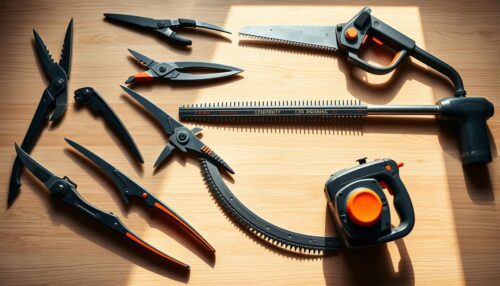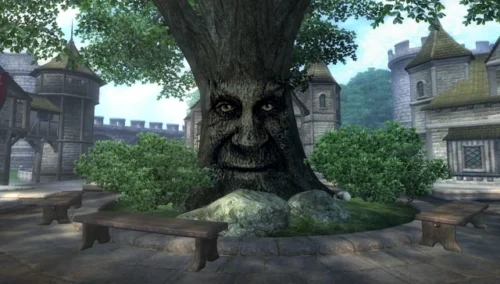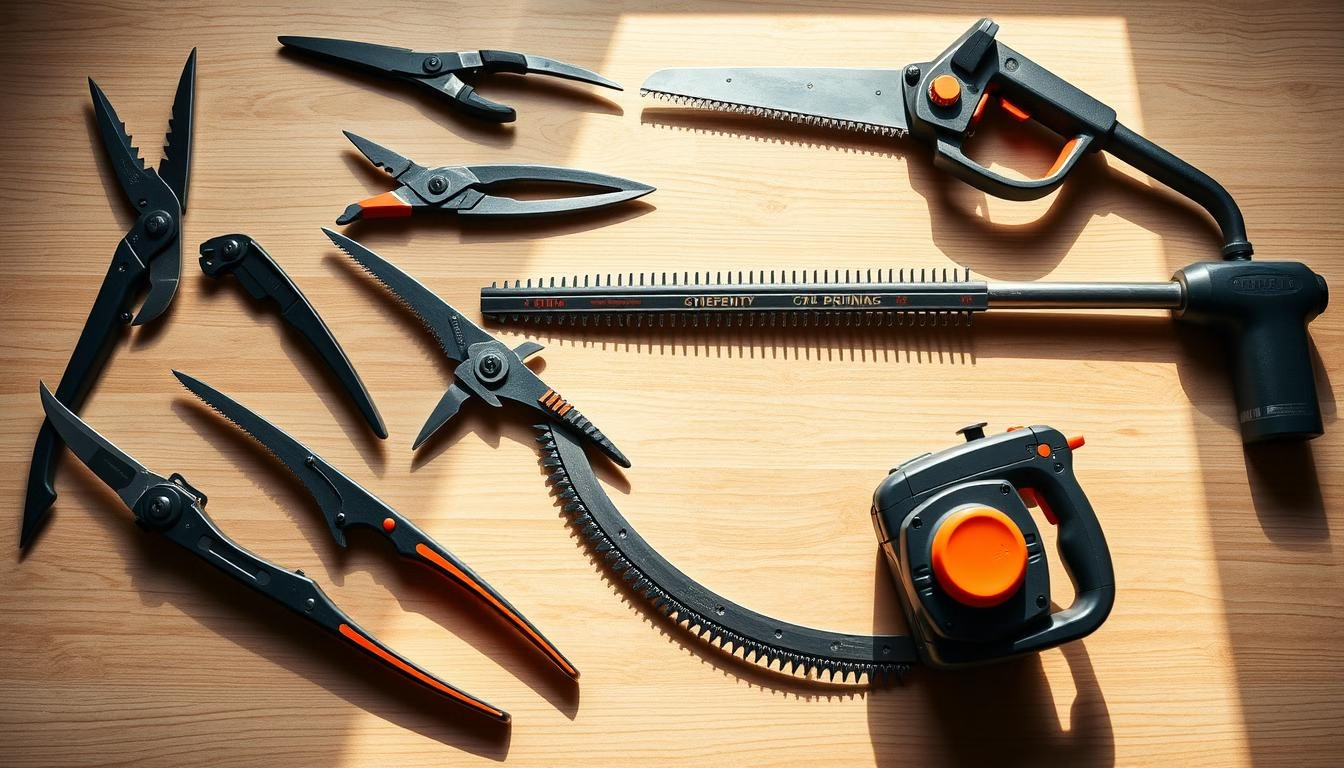Trim Your Trees for Health & Safety: Expert Tips
Trim Your Trees for Health & Safety: Expert Tips, tree pruning and the right tools are key for tree health and safety. Pruning removes dead or diseased branches, boosting tree health and growth. Experts say using quality tools for trimming ensures clean cuts. With the right techniques and tools, your trees will look better and be safer.
Regular trimming is vital for tree health and safety. It’s important to use the correct tools and methods for the job. Sharp tools make cuts cleaner, helping trees heal faster. By choosing the right tools and techniques, your trees will thrive.
Key Takeaways
- Regular tree trimming is essential for maintaining the health and safety of your trees.
- Proper tree pruning techniques and tree trimming tools can improve the overall health and appearance of your trees.
- High-quality tree trimming tools are necessary for effective tree trimming.
- Sharp blades can improve cutting efficiency and enhance healing time.
- Proper pruning can reduce the risk of falling branches and tree-related accidents.
- Regular tree trimming can improve branch structure and tree stability, reducing risks associated with high winds and storms.
Understanding the Importance of Proper Tree Trimming
Proper tree trimming is key for keeping trees healthy and safe. Regular trimming stops disease spread and lowers accident risks. A pro arborist offers great tree care tips for safe and right trimming.
Some benefits of proper tree trimming include:
- Improved air circulation, which can reduce the risk of fungal infections
- Enhanced aesthetic appeal, which can increase property value
- Reduced risk of branch failure, which can prevent injuries and property damage
Prune trees in late fall or winter, when they’re dormant and less likely to get hurt from pruning. It’s smart to hire a certified arborist for safe and proper pruning. By doing this, you keep your trees healthy and safe, and make your property look better.
| Tree Trimming Benefits | Description |
|---|---|
| Improved Air Circulation | Reduces risk of fungal infections |
| Enhanced Aesthetic Appeal | Increases property value |
| Reduced Risk of Branch Failure | Prevents injuries and property damage |
Essential Tools and Equipment for Tree Trimming
Tree trimming needs the right tools for safety and success. Pruning saws and loppers make cutting easier. Loppers can cut branches up to 3 inches wide. Pruning saws handle branches up to 3 inches thick and. Keeping tools sharp boosts their performance and life and.
Key tools for tree trimming include:
- Pruning shears, which can cut branches up to 1 inch in diameter and
- Loppers, which can cut branches up to 2 inches in diameter and
- Pruning saws, which can cut branches up to 3 inches in diameter and
- Pole pruners, which can reach branches as high as 30 feet
Trim Your Trees for Health & Safety: Expert Tips
Wearing gloves and safety glasses is crucial for safetyand. With the right tools and safety gear, tree trimming can be safe and successful.
How to Trim Trees for Health and Safety: Basic Techniques
Tree pruning techniques are key for keeping trees healthy and safe. It’s important to cut at the right angle and know how to identify the branch collar to avoid harming the tree. Always make clean cuts just outside the branch collar to help the tree heal faster.
When it comes to trimming, size matters. Cutting too much of the tree’s leaves can stress it out and even harm it. It’s best to remove no more than a quarter of the leaves at once to keep the tree healthy.
Some important things to keep in mind when pruning trees include:
- Removing dead or damaged limbs to make the tree safer
- Pruning during the tree’s dormant season to help it grow better
- Don’t over-prune, as it can hurt the tree’s ability to make food and make it more vulnerable to diseases
By using these basic pruning techniques and thinking about what your trees need, you can keep them healthy and safe. This will also make your landscape look better.
| Tree Type | Pruning Recommendations |
|---|---|
| Deciduous Trees | Prune 6-8 weeks before bud break |
| Evergreen Trees | Prune minimally throughout the growing season |
Signs Your Trees Need Trimming
Regular tree trimming is key for keeping trees healthy and safe. Mature trees should be pruned every few years. This keeps them looking good and safe. Signs like overgrown branches or dead limbs mean it’s time for a trim.
Looking for structural warning signs is also important. Cracks in the bark or uneven growth are signs of trouble.
Some common signs that a tree needs trimming include:
- Overgrown branches
- Dead or dying branches
- Dense tree canopies
- Unbalanced tree shapes
- Diseased branches
These signs can mean the tree has health problems. Problems like disease or pests can harm the tree.
It’s crucial to trim trees when needed. This stops damage and keeps trees healthy and safe. Spotting damage early helps prevent accidents and keeps trees thriving.
| Signs of Tree Damage | Description |
|---|---|
| Overgrown branches | Branches that are too long or too dense, posing a hazard to people and property |
| Dead or dying branches | Branches that are dead, dying, or diseased, which can fall and cause damage or injury |
| Dense tree canopies | Tree canopies that are too dense, preventing sunlight and air from reaching the tree and surrounding plants |
Seasonal Timing for Tree Trimming
Timing is key when it comes to tree pruning. The best time to prune most trees is during their dormant season, which is late winter or early spring. This ensures the best results and helps avoid disease and pests. A good tree pruning schedule is vital for your trees’ health and safety.
For deciduous trees, prune from February to March. Prune oak trees from December to February to avoid oak wilt. Prune evergreen shrubs in late March or early April before new growth starts. It’s important to tailor your seasonal tree trimming plan to your trees’ needs.
Pruning in the dormant season has many benefits. It reduces sap flow, which means less “bleeding” and fewer pests. It also encourages new growth, improves air circulation, and prevents disease. A well-planned winter pruning schedule keeps your trees healthy and safe.
Here are some tips for a tree pruning schedule: * Prune deciduous trees during their dormant season * Prune evergreen shrubs in late March or early April * Tailor your seasonal tree trimming plan to your trees’ needs By following these tips and considering your trees’ unique needs, you can create an effective tree pruning schedule. This will help keep your trees healthy and safe.
| Tree Type | Best Pruning Time |
|---|---|
| Deciduous Trees | February – March |
| Oak Trees | December – February |
| Evergreen Shrubs | Late March – Early April |
Safety Protocols During Tree Maintenance
Tree trimming safety is key in tree care. It needs careful planning and action to avoid accidents. When dealing with big trees or heavy branches, wearing gloves and eye protection is crucial. This gear helps prevent injuries and keeps the work area safe.
Using personal protection equipment is essential for tree trimming safety. This includes hard hats, gloves, and leg protection. Workers should also be mindful of their surroundings and take steps to avoid accidents. For instance, they should always assume power lines are live and keep a safe distance.
Having a plan for emergencies is vital. This includes having a first aid kit ready and knowing how to handle common injuries like cuts and falls. The plan should also cover how to evacuate the area and get medical help if needed.
Some key safety tips for tree trimming and removal include:
- Wearing protective equipment, such as hard hats and gloves
- Inspecting tools and equipment before use
- Avoiding work near power lines
- Establishing a drop zone and hazard zone
By following these safety protocols and using the right personal protection equipment, workers can reduce the risk of accidents. This ensures a safe working environment.
Tree trimming safety goes beyond just following protocols. It’s also about being aware of potential hazards and taking steps to avoid them. By doing this, workers can ensure a safe and successful tree maintenance operation.

| Safety Tip | Description |
|---|---|
| Wear protective equipment | Hard hats, gloves, and leg protection can help prevent injuries |
| Inspect tools and equipment | Regular inspection can help identify potential hazards and prevent accidents |
| Avoid work near power lines | Assume all power lines are energized and maintain a safe distance |
Common Tree Trimming Mistakes to Avoid
Tree trimming is key to keeping your trees healthy and safe. But, tree trimming mistakes can cause big problems. Over-pruning, for example, can stress the tree and hurt its growth. It’s important to steer clear of incorrect cutting techniques that can damage the tree and shorten its life.
Some common mistakes to avoid include:
- Over-pruning, which can remove too many leaves and affect the tree’s ability to produce food
- Incorrect cutting techniques, such as flush cuts or stub cuts, which can leave the tree vulnerable to decay and pests
- Using dull or inappropriate tools, which can lead to larger wounds and damage the tree
Avoiding these mistakes is key to keeping your trees healthy. By understanding the risks of tree trimming mistakes and taking steps to avoid them, you can help your trees thrive. This way, they can stay beautiful and valuable for a long time.
Remember, proper tree trimming techniques are vital for your trees’ health and safety. By avoiding common mistakes and using the right techniques, you can help your trees grow strong and healthy. This way, you can enjoy their beauty for many years to come.
| Mistake | Consequence |
|---|---|
| Over-pruning | Stress, poor growth, and increased risk of disease |
| Incorrect cutting techniques | Decay, pests, and reduced lifespan |
When to Call a Professional Arborist
For complex tree trimming needs, it’s crucial to hire a professional arborist for safety and proper care. They offer expert advice and services like pruning and removal. Pruning is best done during the tree’s dormant season. A pro can suggest the best time and method based on the tree’s type, health, and growth.
Signs like yellow leaves, wilting, and early leaf drop mean your tree might be stressed. Also, if you see major cracks, leaning, or root problems, get a pro’s help. They can check your tree’s health and suggest the best action, like pruning or removal.

Choosing a professional arborist ensures your trees get the care they need. This boosts your property’s beauty and value, keeping it safe. If you’re unsure about tree care or need advice, call a professional arborist for their services.
| Tree Care Service | Benefits |
|---|---|
| Pruning | Improves tree health, enhances appearance, and reduces risk of branch failure |
| Removal | Eliminates safety hazards, prevents property damage, and allows for new tree growth |
| Tree Assessment | Identifies potential issues, provides expert advice, and helps maintain tree health |
Conclusion: Maintaining Healthy and Safe Trees Year-Round
Keeping your trees healthy and safe is a big job that needs constant effort. We’ve seen how regular tree trimming helps trees breathe better and get more sunlight. This boosts their health and helps them grow. It also lowers the chance of branches falling in storms, which is dangerous for your home and family. Plus, well-kept trees can make your house more valuable, attracting buyers.
To keep your trees in top shape, make a regular care plan. Trim them in late winter or early spring when they’re not growing. This helps them heal and grow better. Regular checks and care can stop up to 80% of tree problems. Using pros can cut tree death rates by over 50%. But, bad pruning can hurt a tree’s ability to make food, slowing its growth by up to 25%.
By using the tips from this article, you can keep your trees healthy all year. This ensures they keep giving you benefits like cleaner air and a higher home value. Start taking care of your trees today to keep them strong and your home safe for many years.
FAQ
What are the benefits of proper tree trimming?
Proper tree trimming boosts tree health and safety. It also increases your property’s value.
What tools and equipment are needed for tree trimming?
You’ll need pruning saws, loppers, and pole pruners. Choosing the right tools is key.
What are the basic techniques for trimming trees?
Start with the right cutting angles and identify the branch collar. Follow size-based guidelines for clean cuts and to avoid damage.
What are the signs that indicate a tree needs trimming?
Look for visual signs, structural warnings, and health symptoms. These can mean it’s time to trim the tree.
When is the best time to trim trees?
Prune during the dormant season for health benefits. But, the best time varies by tree species and growth rate.
What safety protocols should be followed during tree maintenance?
Wear personal protection gear and use proper techniques for heights. Know emergency procedures for a safe work area.

What common mistakes should be avoided when trimming trees?
Avoid over-pruning and using wrong cutting methods. Also, prevent tool errors that harm the tree.
When should a professional arborist be called for tree trimming?
Call a professional arborist for big or complex tree jobs. They have the expertise needed.
